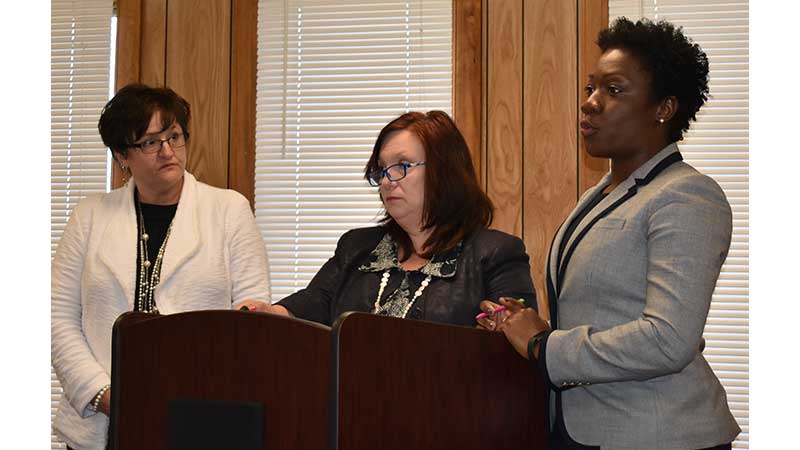School to revamp gifted program
Published 7:41 am Friday, April 19, 2019

- Dr. Julie Gilliam, Prince Edward County Public Schools Assistant Superintendent, left, presented a proposal to implement new identification and testing strategies for gifted students with Ruth Williamson, Coordinator of Exceptional Programs, middle, and Gifted Coordinator for School District U-46 April Wells, right. (Photo by Emily Hollingsworth)
To address a prominent issue of underrepresentation in gifted education at public schools, Prince Edward County Public Schools (PECPS) introduced a proposed plan that would help identify students who may have often been overlooked.
The plan was introduced by division Superintendent Dr. Barbara Johnson and presented by Assistant Superintendent Dr. Julie Gilliam, Gifted Student Coordinator Ruth Williamson and Consultant April Wells, who serves as the gifted coordinator for School District U-46 District in Illinois.
Changes proposed for the gifted program include implementing universal screenings for all students in first and fourth grades using measures that test students’ intellectual ability. Students who score at the 90th percentile or above on ability or achievement testing will be recommended for additional testing.
How students will be identified is proposed to change. The school division is proposed to compare the scores of students locally rather than comparing the scores of students to national norms.
The current gifted student program identifies students as gifted who score at the 98th percentile on two nationally norm-referenced tests. Other identification measures include parent and teacher rating scales, taking into consideration the student’s grade-point average and being evaluated based upon parent or teacher recommendation.
The proposed program is meant to create a gifted student body that reflects the student body of the school division and meets the needs of the gifted students.
The new program is also set to identify gifted students who may have been overlooked due to constraints of the current program.
“We propose moving from a restrictive referral process to a more equitable process that includes more universal screening,” Williamson said. “Universal screening means that every child has the opportunity to be tested. By removing the barrier to identification, we can address underrepresentation.”
The presentation cited that 69 percent of the current student population in the PECPS gifted program are Caucasian, but Caucasian students only make up 38 percent of the student body at PECPS. Approximately 23 percent in the gifted student program are African-American, but African-American students make up 57 percent of the total student body at PECPS.
Asian students represent 4 percent of the gifted student population, but represent 2 percent of the student population. Hispanic students represent 3 percent of the gifted student population and 3 percent of the total student population.
“The goal with the redesign as we propose with some of the changes is that we no longer leave that talent on the sidelines,” Wells said. “The talent we’re happening to leave on the sidelines represents an invaluable resource here in Prince Edward County as well as globally. And we can put in systems to address the underrepresentation. Underrepresentation doesn’t have to happen. We can do something about it.”
The current requirement of parent or teacher recommendation has potentially deterred students from more diverse backgrounds from being tested.
“According to a 2016 study by Vanderbilt University, black students are 66 percent less likely to be referred for gifted programs then their white classmates,” Wells said in an email. “Hispanic students are 47 percent less likely to be referred than their white classmates.”
Wells said that the current standards implemented by PECPS are among the more rigorous standards compared with standards used around the country.
The proposed gifted student program provides professional development opportunities for teachers and administrators on the characteristics and needs of students from underrepresented populations.
Dr. Timothy Corbett, Leigh District school board member, thanked the school division for examining the program.
“I was identified as gifted, but I don’t think with the criteria here that I would have been,” Corbett said, in reference to the current measures established in the school division.
Addressing a nationwide issue
“The whole issue of diversity in gifted programs is not just a state issue, or a local issue, that’s a national issue, and has been for quite some time,” Dr. Donna Poland, specialist, gifted education and Governor’s schools principal investigator with the Virginia Department of Education said in an interview Thursday.
National gifted student programs have taken steps to provide guidance to school divisions in how to examine its current identification and testing standards for gifted students and ways they could be changed to recognize and promote students from diverse backgrounds. Universal screenings and using local comparisons as opposed to national comparisons are among some of these solutions.
The challenge, Poland said, is that each school division has a different way of operating when it comes to gifted student programming. There are 132 school divisions in Virginia, and all have slightly different approaches to their programs.
Universal screening, Poland said, has the potential to identify students from culturally diverse backgrounds and students of low socioeconomic classes, many of whom may be overlooked with other measures.





